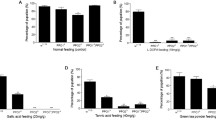Abstract
Glutathione transferase activity towards various plant isothiocyanates was studied in larvae of the two generalists, fall armyworm [Spodoptera frugiperda (J.E. Smith)], and cabbage looper [Trichoplusia ni (Hübner)], and the specialist, velvetbean caterpillar (Anticarsia gemmatalis Hübner) using the midgut soluble fraction as enzyme source. The generalists, but not the specialist, are adapted to feeding on isothiocyanate-containing crucifers. Allyl and benzyl isothiocyanate were found to be metabolized by glutathione transferase from the two generalist species, but no activity was detected with the specialist. The transferase activity towards these allelochemicals in the cabbage looper was two- to sixfold higher than that in the fall armyworm. In all instances, activity was induced by various allelochemicals including indole 3-acetonitrile, indole 3-carbinol, flavone, xanthotoxin, and its own substrates. The induction ranged from 1.3- to 10.1-fold depending on the allelochemical, with the fall armyworm being more inducible. The transferase system of fall armyworm also metabolized another analog, 2-phenylethyl isothiocyanate, but activity can only be observed after induction. Bioassay results showed that these isothiocyanates were all toxic to the lepidopterans, causing acute toxicity in neonates and final-instar larvae. The results suggest that glutathione transferase plays an important role in the detoxification of isothiocyanates and hence food-plant adaptation in phytophagous insects.
Similar content being viewed by others
References
Boyland, E., andChasseaud, L.F. 1967. Enzyme-catalyzed conjugations of glutathione with unsaturated compounds.Biochem. J. 104:95–122.
Boyland, E., andChasseaud, L.F. 1969. The role of glutathione and glutathione S-transferases in mercapturic acid biosynthesis.Adv. Enzymol. 32:173–219.
Bradford, M.M. 1976. A rapid and sensitive method for the quantitation of microgram quantities of protein utilizing the principles of protein-dye binding.Anal. Biochem. 72:248–254.
Brüsewitz, G., Cameron, B.D., Chausseaud, L.F., Görler, K., Hawkins, D.R., Koch, H., andMennicke, W.H. 1977. The metabolism of benzyl isothiocyanate and its cysteine conjugate.Biochem. J. 162:99–107.
Burton, R.L. 1969. Mass rearing the corn earworm in the laboratory.USDA Agric. Res. Serv. ARS No. 33–134, 8 pp.
Christian, M.F., andYu, S.J. 1986. Cytochrome P-450-dependent monooxygenase activity in the velvetbean caterpillar,Anticarsia gemmatalis Hübner.Comp. Biochem. Physiol. 83C:23–27.
Clark, A.G., andShamaan, N.A. 1984. Evidence that DDT-dehydrochlorinase from the house fly is a glutathione S-transferase.Pestic. Biochem. Physiol. 22:249–261.
Das, M., Bickers, D.R., andMukhtar, H. 1984. Plant phenols as in vitro inhibitors of glutathione S-transferase(s).Biochem. Biophys. Res. Commun. 120:427–433.
Ellman, G.L. 1959. Tissue sulfhydryl groups.Arch. Biochem. Biophys. 82:70–77.
Feeny, P. 1977. Defensive ecology of the Cruciferae.Ann. Mo. Bot. Gard. 64:221–234.
Fenwick, G.R., Heaney, R.K., andMullin, W.J. 1982. Glucosinolates and their breakdown products in food and food plants.CRC Crit. Rev. Food Sci. Nutr. 18:123–201.
Itoh, H., Yoshida, R., Mizuno, T., Kudo, M., Nikuni, S., andKarki, T. 1984. Study on the contents of volatile isothiocyanate of cultivars ofBrassica vegetables.Rep. Natl. Food Res. Inst. No. 45, pp. 33–41.
Kulkarni, A.P., Motoyama, N., Dauterman, W.C., andHodgson, E. 1978. Inhibition of house fly glutathione S-transferase by catecholamines and quinones.Bull. Environ. Contam. Toxicol. 20:227–232.
Lichtenstein, E.P., Morgan, D.G., andMueller, C.H. 1964. Naturally occurring insecticides in cruciferous crops.J. Agric. Food Chem. 12:158–161.
Mennicke, W.H., Gorler, K. andKrumbiegel, G. 1983. Metabolism of some naturally occurring isothiocyanates in the rat,Xenobiotica. 13:203–207.
Motoyama, N., andDauterman, W.C. 1980. Glutathione S-transferases: Their role in the metabolism of organophosphorus insecticides.Rev. Biochem. Toxicol. 2:49–69.
Nair, K.S.S., andMcEwen, F.L. 1976. Host selection by the adult cabbage maggot,Hylemya brassicae (Diptera: Anthomyiidae): Effect of glucosinolates and common nutrients on oviposition.Can. Entomol. 108:1021–1030.
Rodman, J.E., andLouda, S.M. 1984. Phenology of glucosinolate concentrations in roots, stems and leaves ofCardamine cordifolia.Biochem. Syst. Ecol. 12:37–46.
Rodman, J.E., andLouda, S.M. 1985. Seasonal flux of isothiocyanate-yielding glucosinolates in roots, stems and leaves ofCardamine cordifolia.Biochem. Syst. Ecol. 13:405–412.
Sas Institute. 1985. SAS Users Guide: Statistics, Version 5 edn., SAS Institute, Inc., Cary, North Carolina.
Seo, S.T., andTang, C.S. 1982. Hawaiian fruit flies (Diptera: Tephritidae): Toxicity of benzyl isothiocyanate against eggs or 1st instars of three species.J. Econ. Entomol. 75:1132–1135.
Steel, R.G.D., andTorrie, J.H. 1960. Principles and Procedures of Statistics. McGraw-Hill, New York.
Tanaka, K., Nakajima, M., andKurihara, N. 1981. The mechanism of resistance to lindane and hexadeuterated lindane in the third Yumenoshima strain of house fly.Pestic. Biochem. Physiol. 16:149–157.
Thorsteinson, A.J. 1953. The chemotactic responses that determine host specificity in an oligophagous insect (Plutellamaculipennis (Curt.) Lepidoptere).Can. J. Zool. 31:52–72.
Tietz, H.M. 1972. An Index to the Described Life Histories, Early Stages and Hosts of the Macrolepidoptera of the Continental United States and Canada. A.C. Allyn, Sarasota, Florida.
Vincent, C., andStewart, R.K. 1984. Effect of allyl isothiocyanate on field behavior of cruciferfeeding flea beetles (Coleoptera: Chrysomelidae).J. Chem. Ecol. 10:33–39.
Wadleigh, R.W., andYu, S.J. 1987. Glutathione transferase activity of fall armyworm larvae toward α,β-unsaturated carbonyl allelochemicals and its induction by allelochemicals.Insect Biochem. 17:759–764.
Yu, S.J. 1982. Host plant induction of glutathione S-transferase in the fall armyworm.Pestic. Biochem. Physiol. 18:101–106.
Yu, S.J. 1984. Interactions of allelochemicals with detoxication enzymes of insecticide-susceptible and resistant fall armyworms.Pestic. Biochem. Physiol. 22:60–68.
Yu, S.J. 1987a. Microsomal oxidation of allelochemicals in generalist (Spodoptera frugiperda) and semispecialist (Anticarsia gemmatalis) insect.J. Chem. Ecol. 13:423–436.
Yu, S.J. 1987b. Biochemical defense capacity in the spined soldier bug (Podisus maculiventris) and its lepidopterous prey.Pestic. Biochem. Physiol. 28:216–223.
Author information
Authors and Affiliations
Rights and permissions
About this article
Cite this article
Wadleigh, R.W., Yu, S.J. Detoxification of isothiocyanate allelochemicals by glutathione transferase in three lepidopterous species. J Chem Ecol 14, 1279–1288 (1988). https://doi.org/10.1007/BF01019352
Received:
Accepted:
Issue Date:
DOI: https://doi.org/10.1007/BF01019352




